Biomechanical Effect of Various Tibial Bearing Materials in Uni-Compartmental Knee Arthroplasty Using Finite Element Analysis
Abstract
:1. Introduction
2. Materials and Methods
2.1. Computational Model of the Intact Knee Joint
2.2. Computational Model of UKA
2.3. Loading and Boundary Conditions
3. Results
3.1. Intact and UKA Model Validation
3.2. Comparison of Contact Stress on Other Compartments in Regard to Change in Tibial Bearing Material
3.3. Comparison of von Mises Stress in Tibial Bone ROIs in Regard to Change in Tibial Bearing Material
4. Discussion
5. Conclusions
Author Contributions
Funding
Conflicts of Interest
References
- Berger, R.A.; Meneghini, R.M.; Jacobs, J.J.; Sheinkop, M.B.; Della Valle, C.J.; Rosenberg, A.G.; Galante, J.O. Results of unicompartmental knee arthroplasty at a minimum of ten years of follow-up. J. Bone Joint Surg. Am. Vol. 2005, 87, 999–1006. [Google Scholar] [CrossRef]
- Riddle, D.L.; Jiranek, W.A.; McGlynn, F.J. Yearly incidence of unicompartmental knee arthroplasty in the United States. J. Arthroplast. 2008, 23, 408–412. [Google Scholar] [CrossRef] [PubMed]
- Pandit, H.; Jenkins, C.; Gill, H.S.; Barker, K.; Dodd, C.A.; Murray, D.W. Minimally invasive Oxford phase 3 unicompartmental knee replacement: Results of 1000 cases. J. Bone Joint Surg. Br. Vol. 2011, 93, 198–204. [Google Scholar] [CrossRef] [PubMed]
- Berger, R.A.; Nedeff, D.D.; Barden, R.M.; Sheinkop, M.M.; Jacobs, J.J.; Rosenberg, A.G.; Galante, J.O. Unicompartmental knee arthroplasty. Clinical experience at 6- to 10-year followup. Clin. Orthop. Relat. Res. 1999, 367, 50–60. [Google Scholar]
- Suggs, J.F.; Li, G.; Park, S.E.; Sultan, P.G.; Rubash, H.E.; Freiberg, A.A. Knee biomechanics after UKA and its relation to the ACL—A robotic investigation. J. Orthop. Res. 2006, 24, 588–594. [Google Scholar] [CrossRef]
- Murray, D.; Goodfellow, J.; O’Connor, J. The Oxford medial unicompartmental arthroplasty: A ten-year survival study. J. Bone Joint Surg. Br. Vol. 1998, 80, 983–989. [Google Scholar] [CrossRef]
- Aleto, T.J.; Berend, M.E.; Ritter, M.A.; Faris, P.M.; Meneghini, R.M. Early failure of unicompartmental knee arthroplasty leading to revision. J. Arthroplast. 2008, 23, 159–163. [Google Scholar] [CrossRef]
- Parratte, S.; Pauly, V.; Aubaniac, J.M.; Argenson, J.N. No long-term difference between fixed and mobile medial unicompartmental arthroplasty. Clin. Orthop. Relat. Res. 2012, 470, 61–68. [Google Scholar] [CrossRef] [Green Version]
- Stenström, A.; Lewold, S. Multicenter study of unicompartmental knee revision: PCA, Marmor, and St Georg compared in 3777 cases of arthrosis. Acta Orthop. Scand. 1992, 63, 256–259. [Google Scholar]
- Palmer, S.; Morrison, P.; Ross, A. Early catastrophic tibial component wear after unicompartmental knee arthroplasty. Clin. Orthop. Relat. Res. 1998, 350, 143–148. [Google Scholar] [CrossRef]
- Price, A.; Short, A.; Kellett, C.; Beard, D.; Gill, H.; Pandit, H.; Dodd, C.; Murray, D. Ten-year in vivo wear measurement of a fully congruent mobile bearing unicompartmental knee arthroplasty. J. Bone Joint Surg. Br. Vol. 2005, 87, 1493–1497. [Google Scholar] [CrossRef] [PubMed] [Green Version]
- Sathasivam, S.; Walker, P.S. The conflicting requirements of laxity and conformity in total knee replacement. J. Biomech. 1999, 32, 239–247. [Google Scholar] [CrossRef]
- Pruitt, L.A.; Ansari, F.; Kury, M.; Mehdizah, A.; Patten, E.W.; Huddlestein, J.; Mickelson, D.; Chang, J.; Hubert, K.; Ries, M.D. Clinical trade-offs in cross-linked ultrahigh-molecular-weight polyethylene used in total joint arthroplasty. J. Biomed. Mater. Res. B Appl. Biomater. 2013, 101, 476–484. [Google Scholar] [CrossRef] [PubMed]
- Atwood, S.A.; Van Citters, D.W.; Patten, E.W.; Furmanski, J.; Ries, M.D.; Pruitt, L.A. Tradeoffs amongst fatigue, wear, and oxidation resistance of cross-linked ultra-high molecular weight polyethylene. J. Mech. Behav. Biomed. Mater. 2011, 4, 1033–1045. [Google Scholar] [CrossRef] [PubMed]
- Brockett, C.L.; Carbone, S.; Fisher, J.; Jennings, L.M. PEEK and CFR PEEK as an alternative to UHMWPE in total knee replacement. In Proceedings of the ORS Annual Meeting, Las Vegas, NV, USA, 24–28 March 2015. [Google Scholar]
- Brockett, C.L.; Carbone, S.; Fisher, J.; Jennings, L.M. PEEK and CFR-PEEK as alternative bearing materials to UHMWPE in a fixed bearing total knee replacement: An experimental wear study. Wear 2017, 374–375, 86–91. [Google Scholar] [CrossRef]
- Scholes, S.C.; Unsworth, A. Pitch-based carbon-fibre-reinforced poly (ether-ether-ketone) OPTIMA assessed as a bearing material in a mobile bearing unicondylar knee joint. Proc. Inst. Mech. Eng. H 2009, 223, 13–25. [Google Scholar] [CrossRef]
- Pegg, E.C.; Walter, J.; Mellon, S.J.; Pandit, H.G.; Murray, D.W.; D’Lima, D.D.; Fregly, B.J.; Gill, H.S. Evaluation of factors affecting tibial bone strain after unicompartmental knee replacement. J. Orthop. Res. 2013, 31, 821–828. [Google Scholar] [CrossRef] [PubMed]
- Iesaka, K.; Tsumura, H.; Sonoda, H.; Sawatari, T.; Takasita, M.; Torisu, T. The effects of tibial component inclination on bone stress after unicompartmental knee arthroplasty. J. Biomech. 2002, 35, 969–974. [Google Scholar] [CrossRef]
- Zhu, G.D.; Guo, W.S.; Zhang, Q.D.; Liu, Z.H.; Cheng, L.M. Finite element analysis of mobile-bearing unicompartmental knee arthroplasty: The influence of tibial component coronal alignment. Chin. Med. J. 2015, 128, 2873–2878. [Google Scholar] [CrossRef]
- Koh, Y.-G.; Hong, H.-T.; Kang, K.-T. Biomechanical Effect of UHMWPE and CFR-PEEK insert on tibial component in unicompartmental knee replacement in different varus and valgus alignments. Materials 2019, 12, 3345. [Google Scholar] [CrossRef] [Green Version]
- Kim, Y.S.; Kang, K.-T.; Son, J.; Kwon, O.-R.; Choi, Y.-J.; Jo, S.-B.; Choi, Y.W.; Koh, Y.-G. Graft extrusion related to the position of allograft in lateral meniscal allograft transplantation: Biomechanical comparison between parapatellar and transpatellar approaches using finite element analysis. Arthrosc. J. Arthrosc. Relat. Surg. 2015, 31, 2380–2391.e2. [Google Scholar] [CrossRef] [PubMed]
- Kang, K.T.; Kim, S.H.; Son, J.; Lee, Y.H.; Chun, H.J. Computational model-based probabilistic analysis of in vivo material properties for ligament stiffness using the laxity test and computed tomography. J. Mater. Sci. Mater. Med. 2016, 27, 183. [Google Scholar] [CrossRef] [PubMed]
- Kwon, O.R.; Kang, K.T.; Son, J.; Suh, D.S.; Baek, C.; Koh, Y.G. Importance of joint line preservation in unicompartmental knee arthroplasty: Finite element analysis. J. Orthop. Res. 2017, 35, 347–352. [Google Scholar] [CrossRef] [PubMed]
- Kang, K.T.; Kim, S.H.; Son, J.; Lee, Y.H.; Kim, S.; Chun, H.J. Probabilistic evaluation of the material properties of the in vivo subject-specific articular surface using a computational model. J. Biomed. Mater. Res. B Appl. Biomater. 2017, 105, 1390–1400. [Google Scholar] [CrossRef]
- Kang, K.T.; Son, J.; Suh, D.S.; Kwon, S.K.; Kwon, O.R.; Koh, Y.G. Patient-specific medial unicompartmental knee arthroplasty has a greater protective effect on articular cartilage in the lateral compartment: A finite element analysis. Bone Joint Res. 2018, 7, 20–27. [Google Scholar] [CrossRef]
- Pena, E.; Calvo, B.; Martinez, M.A.; Palanca, D.; Doblare, M. Why lateral meniscectomy is more dangerous than medial meniscectomy. A finite element study. J. Orthop. Res. 2006, 24, 1001–1010. [Google Scholar] [CrossRef]
- Kayabasi, O.; Ekici, B. The effects of static, dynamic and fatigue behavior on three-dimensional shape optimization of hip prosthesis by finite element method. Mater. Des. 2007, 28, 2269–2277. [Google Scholar] [CrossRef]
- Hoffler, C.; Moore, K.; Kozloff, K.; Zysset, P.; Goldstein, S.A. Age, gender, and bone lamellae elastic moduli. J. Orthop. Res. 2000, 18, 432–437. [Google Scholar] [CrossRef]
- Shepherd, D.E.; Seedhom, B.B. The ‘instantaneous’ compressive modulus of human articular cartilage in joints of the lower limb. Rheumatology (Oxford) 1999, 38, 124–132. [Google Scholar] [CrossRef] [Green Version]
- Donahue, T.L.H.; Hull, M.; Rashid, M.M.; Jacobs, C.R. How the stiffness of meniscal attachments and meniscal material properties affect tibio-femoral contact pressure computed using a validated finite element model of the human knee joint. J. Biomech. 2003, 36, 19–34. [Google Scholar] [CrossRef]
- Guess, T.M.; Thiagarajan, G.; Kia, M.; Mishra, M. A subject specific multibody model of the knee with menisci. Med. Eng. Phys. 2010, 32, 505–515. [Google Scholar] [CrossRef]
- Takeda, Y.; Xerogeanes, J.W.; Livesay, G.A.; Fu, F.H.; Woo, S.L. Biomechanical function of the human anterior cruciate ligament. Arthrosc. J. Arthrosc. Relat. Surg. 1994, 10, 140–147. [Google Scholar] [CrossRef]
- Blankevoort, L.; Huiskes, R. Validation of a three-dimensional model of the knee. J. Biomech. 1996, 29, 955–961. [Google Scholar] [CrossRef] [Green Version]
- Zimmer, I. Zimmer® Unicompartmental High Flex Knee: Intramedullary, Spacer Block Option and Extramedullary Minimally Invasive Surgical Techniques; Zimmer, Inc.: Warsaw, IN, USA, 2010. [Google Scholar]
- Inoue, S.; Akagi, M.; Asada, S.; Mori, S.; Zaima, H.; Hashida, M. The valgus inclination of the tibial component increases the risk of medial tibial condylar fractures in unicompartmental knee arthroplasty. J. Arthroplast. 2016, 31, 2025–2030. [Google Scholar] [CrossRef]
- Godest, A.C.; Beaugonin, M.; Haug, E.; Taylor, M.; Gregson, P.J. Simulation of a knee joint replacement during a gait cycle using explicit finite element analysis. J. Biomech. 2002, 35, 267–275. [Google Scholar] [CrossRef]
- Innocenti, B.; Truyens, E.; Labey, L.; Wong, P.; Victor, J.; Bellemans, J. Can medio-lateral baseplate position and load sharing induce asymptomatic local bone resorption of the proximal tibia? A finite relement study. J. Orthop. Surg. Res. 2009, 4, 26. [Google Scholar] [CrossRef] [Green Version]
- Kang, K.-T.; Koh, Y.-G.; Son, J.; Yeom, J.S.; Park, J.-H.; Kim, H.-J. Biomechanical evaluation of pedicle screw fixation system in spinal adjacent levels using polyetheretherketone, carbon-fiber-reinforced polyetheretherketone, and traditional titanium as rod materials. Compos. Part B Eng. 2017, 130, 248–256. [Google Scholar] [CrossRef]
- Innocenti, B.; Pianigiani, S.; Ramundo, G.; Thienpont, E. Biomechanical effects of different varus and valgus alignments in medial unicompartmental knee arthroplasty. J. Arthroplast. 2016, 31, 2685–2691. [Google Scholar] [CrossRef]
- Knight, L.A.; Pal, S.; Coleman, J.C.; Bronson, F.; Haider, H.; Levine, D.L.; Taylor, M.; Rullkoetter, P.J. Comparison of long-term numerical and experimental total knee replacement wear during simulated gait loading. J. Biomech. 2007, 40, 1550–1558. [Google Scholar] [CrossRef]
- Greco, A.C.; Erck, R.; Ajayi, O.; Fenske, G. Effect of reinforcement morphology on high-speed sliding friction and wear of PEEK polymers. Wear 2011, 271, 2222–2229. [Google Scholar] [CrossRef]
- Suggs, J.F.; Li, G.; Park, S.E.; Steffensmeier, S.; Rubash, H.E.; Freiberg, A.A. Function of the anterior cruciate ligament after unicompartmental knee arthroplasty: An in vitro robotic study. J. Arthroplast. 2004, 19, 224–229. [Google Scholar] [CrossRef] [PubMed]
- International Organization for Standardization. ISO 14243-1: Implants for Surgery—Wear of Total Knee-Joint Prostheses—Part 1: Loading and Displacement Parameters for Wear-Testing Machines with Load Control and Corresponding Environmental Conditions for Test; ISO: Geneva, Switzerland, 2002. [Google Scholar]
- Halloran, J.P.; Clary, C.W.; Maletsky, L.P.; Taylor, M.; Petrella, A.J.; Rullkoetter, P.J. Verification of predicted knee replacement kinematics during simulated gait in the Kansas knee simulator. J. Biomech. Eng. 2010, 132, 081010. [Google Scholar] [CrossRef]
- Kutzner, I.; Heinlein, B.; Graichen, F.; Bender, A.; Rohlmann, A.; Halder, A.; Beier, A.; Bergmann, G. Loading of the knee joint during activities of daily living measured in vivo in five subjects. J. Biomech. 2010, 43, 2164–2173. [Google Scholar] [CrossRef]
- Kang, K.T.; Koh, Y.G.; Son, J.; Kwon, O.R.; Baek, C.; Jung, S.H.; Park, K.K. Measuring the effect of femoral malrotation on knee joint biomechanics for total knee arthroplasty using computational simulation. Bone Joint Res. 2016, 5, 552–559. [Google Scholar] [CrossRef]
- Li, C.S.; Vannabouathong, C.; Sprague, S.; Bhandari, M. The use of carbon-fiber-reinforced (CFR) PEEK material in orthopedic implants: A systematic review. Clin. Med. Insights Arthritis Musculoskelet. Disord. 2015, 8. [Google Scholar] [CrossRef] [PubMed]
- Escobar, A.; Quintana, J.; Bilbao, A.; Arostegui, I.; Lafuente, I.; Vidaurreta, I. Responsiveness and clinically important differences for the WOMAC and SF-36 after total knee replacement. Osteoarthr. Cartil. 2007, 15, 273–280. [Google Scholar] [CrossRef] [Green Version]
- Brander, V.A.; Stulberg, S.D.; Adams, A.D.; Harden, R.N.; Bruehl, S.; Stanos, S.P.; Houle, T. Ranawat Award Paper: Predicting total knee replacement pain: A prospective, observational study. Clin. Orthop. Relat. Res. 2003, 416, 27–36. [Google Scholar] [CrossRef] [PubMed]
- Tay, K.S.; Lo, N.N.; Yeo, S.J.; Chia, S.-L.; Tay, D.; Chin, P.L. Revision total knee arthroplasty: Causes and outcomes. Ann. Acad. Med. Singapore 2013, 42, 178–183. [Google Scholar]
- Sharkey, P.F.; Hozack, W.J.; Rothman, R.H.; Shastri, S.; Jacoby, S.M. Why are total knee arthroplasties failing today? Clin. Orthop. Relat. Res. 2002, 404, 7–13. [Google Scholar] [CrossRef]
- Kurtz, S.M.; Devine, J.N. PEEK biomaterials in trauma, orthopedic, and spinal implants. Biomaterials 2007, 28, 4845–4869. [Google Scholar] [CrossRef] [Green Version]
- Kurtz, S.M. Editorial Comment: Advances in PEEK Technology. Clin. Orthop. Relat. Res. 2016, 474, 2362–2363. [Google Scholar] [CrossRef] [PubMed] [Green Version]
- Brockett, C.L.; Carbone, S.; Abdelgaied, A.; Fisher, J.; Jennings, L.M. Influence of contact pressure, cross-shear and counterface material on the wear of PEEK and CFR-PEEK for orthopaedic applications. J. Mech. Behav. Biomed. Mater. 2016, 63, 10–16. [Google Scholar] [CrossRef] [PubMed] [Green Version]
- Scholes, S.C.; Unsworth, A. Wear studies on the likely performance of CFR-PEEK/CoCrMo for use as artificial joint bearing materials. J. Mater. Sci. Mater. Med. 2009, 20, 163–170. [Google Scholar] [CrossRef] [PubMed]
- Scholes, S.; Unsworth, A.J.W. The wear performance of PEEK-OPTIMA based self-mating couples. Wear 2010, 268, 380–387. [Google Scholar] [CrossRef]
- Kwon, O.R.; Kang, K.T.; Son, J.; Kwon, S.K.; Jo, S.B.; Suh, D.S.; Choi, Y.J.; Kim, H.J.; Koh, Y.G. Biomechanical comparison of fixed- and mobile-bearing for unicomparmental knee arthroplasty using finite element analysis. J. Orthop. Res. 2014, 32, 338–345. [Google Scholar] [CrossRef] [PubMed]
- Innocenti, B.; Bilgen, O.F.; Labey, L.; van Lenthe, G.H.; Sloten, J.V.; Catani, F. Load sharing and ligament strains in balanced, overstuffed and understuffed UKA. A validated finite element analysis. J. Arthroplast. 2014, 29, 1491–1498. [Google Scholar] [CrossRef]
- Bartel, D.L.; Burstein, A.H.; Santavicca, E.A.; Insall, J.N. Performance of the tibial component in total knee replacement. J. Bone Joint Surg. 1982, 64, 1026–1033. [Google Scholar] [CrossRef]
- Bourne, R.B.; Finlay, J.B. The influence of tibial component intramedullary stems and implant-cortex contact on the strain distribution of the proximal tibia following total knee arthroplasty. An in vitro study. Clin. Orthop. Relat. Res. 1986, 208, 95–99. [Google Scholar] [CrossRef]
- Taylor, M.; Tanner, K.E.; Freeman, M.A. Finite element analysis of the implanted proximal tibia: A relationship between the initial cancellous bone stresses and implant migration. J. Biomech. 1998, 31, 303–310. [Google Scholar] [CrossRef]
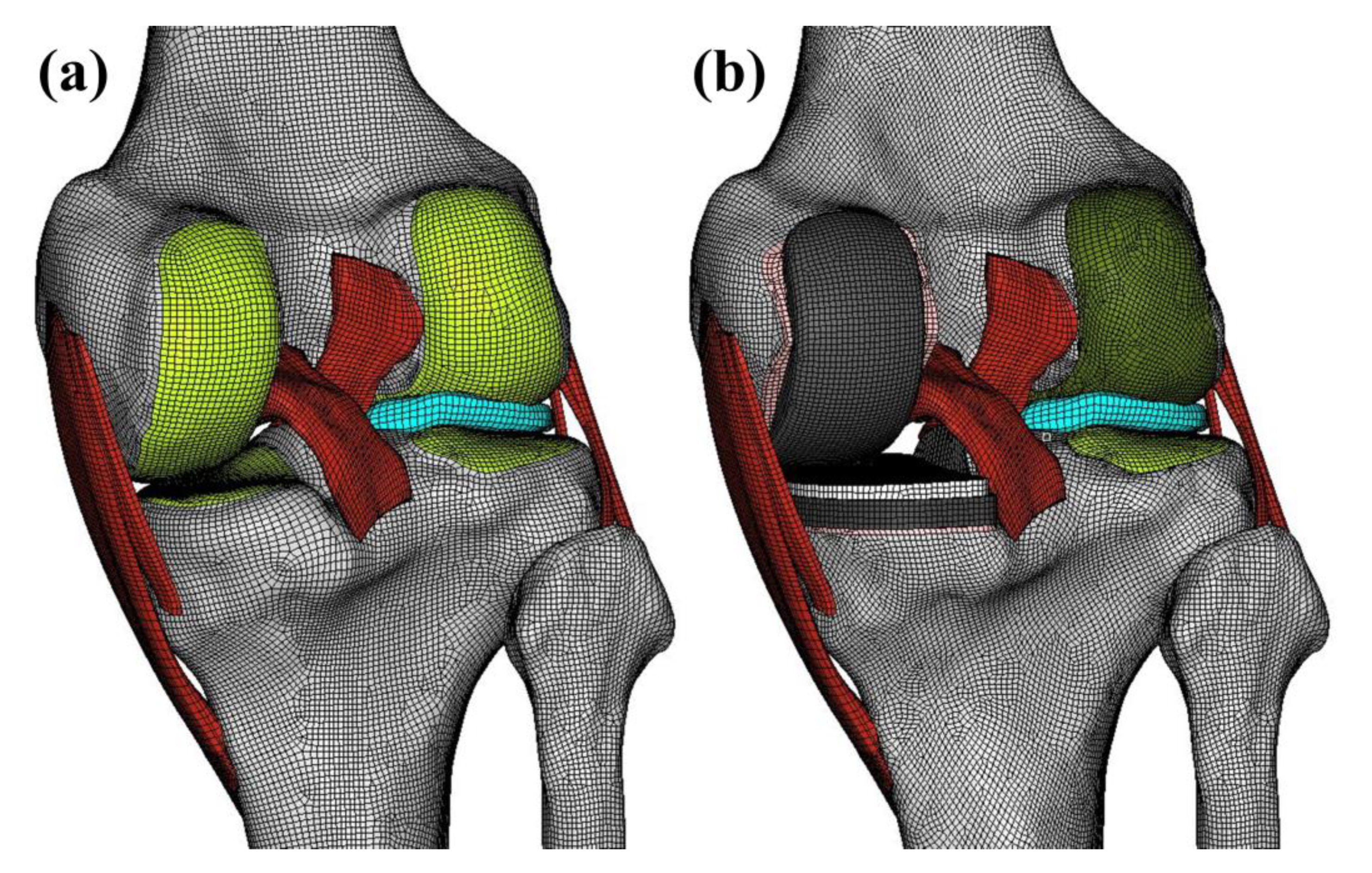

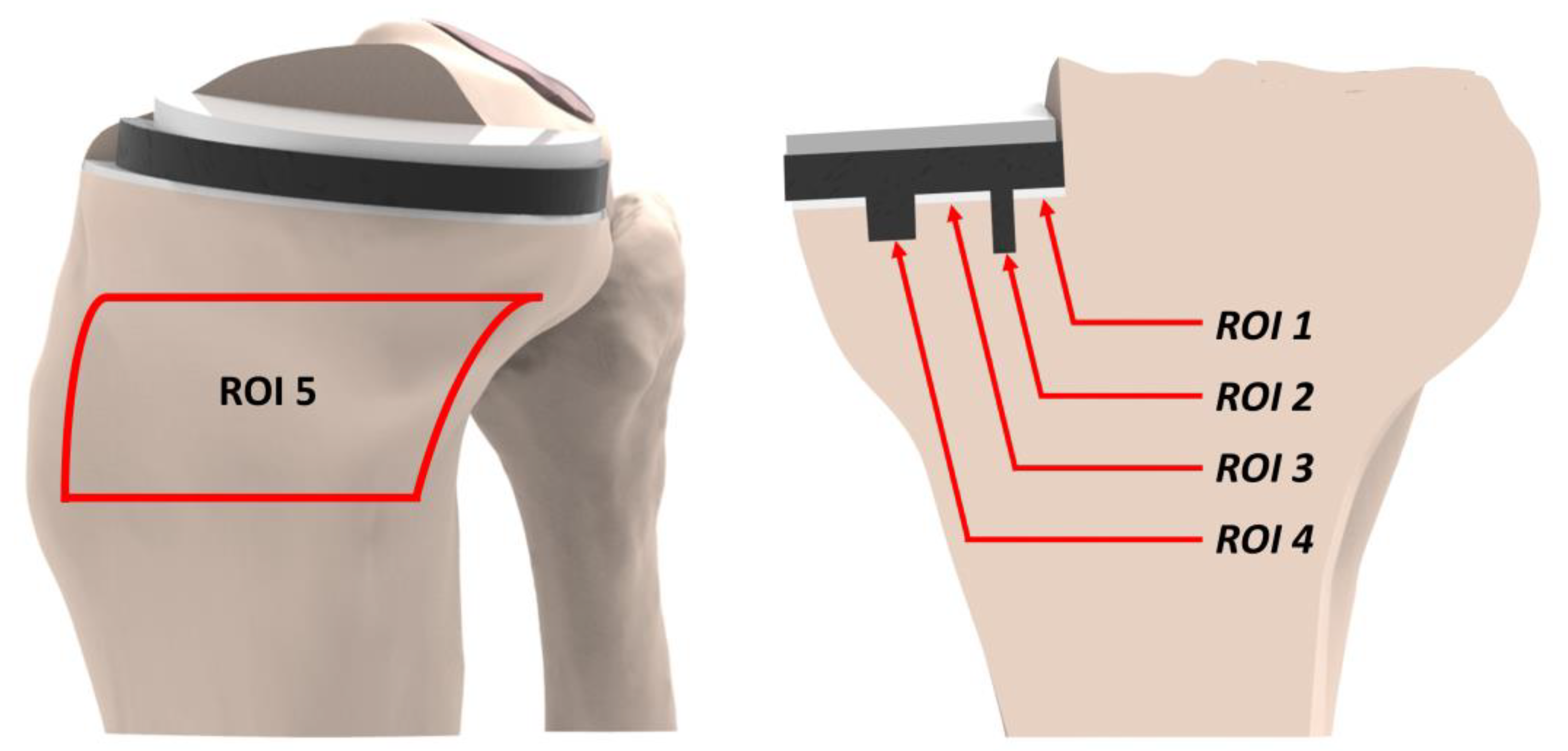

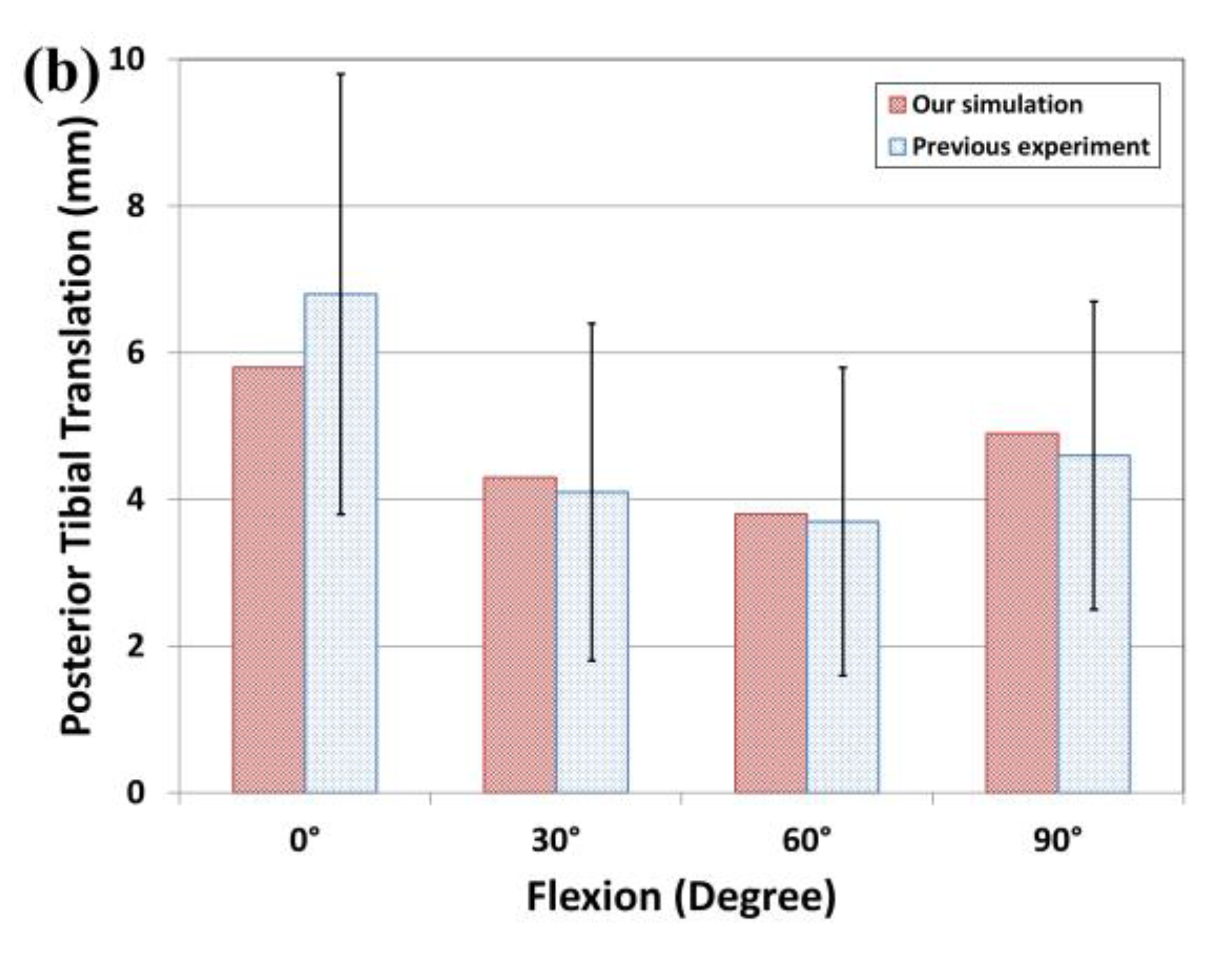


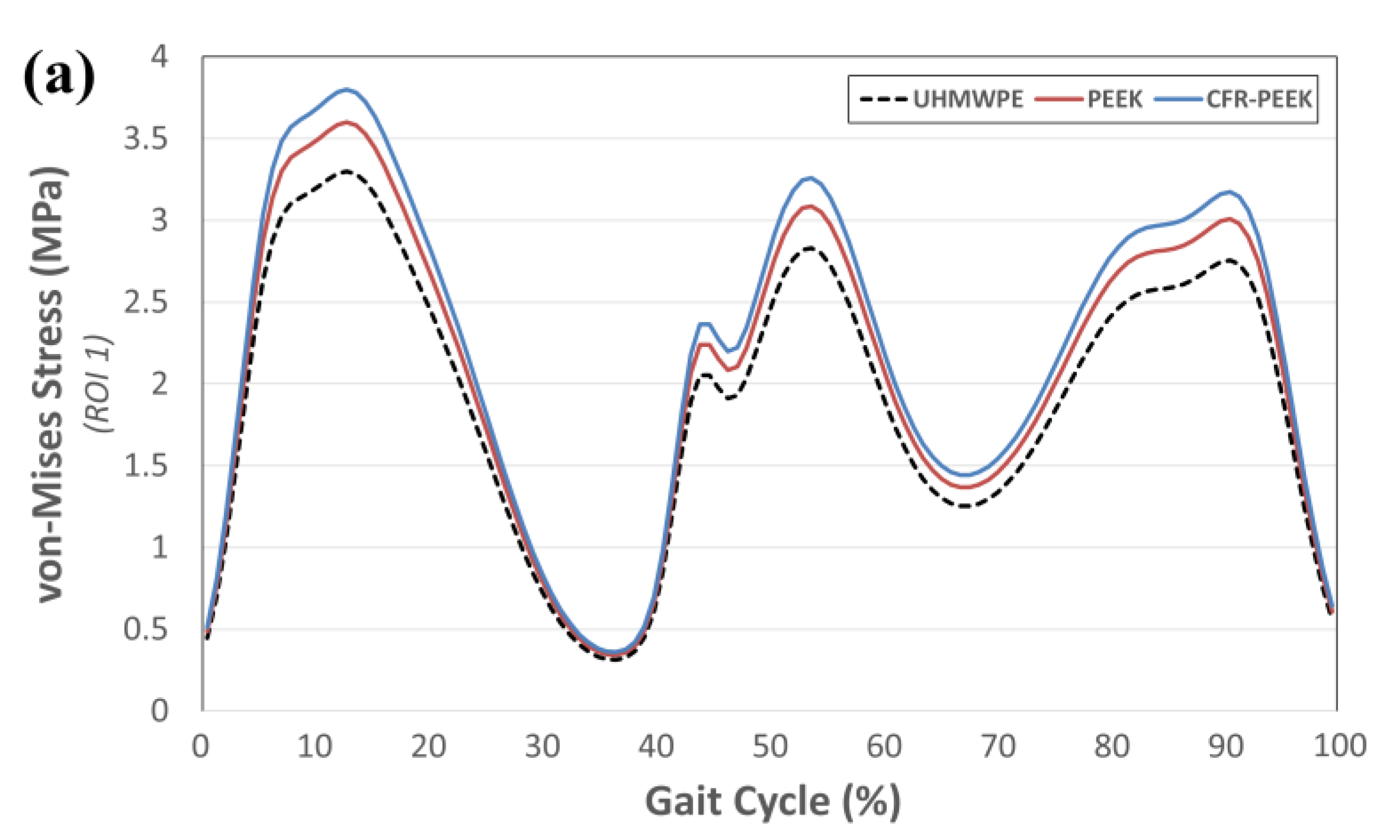

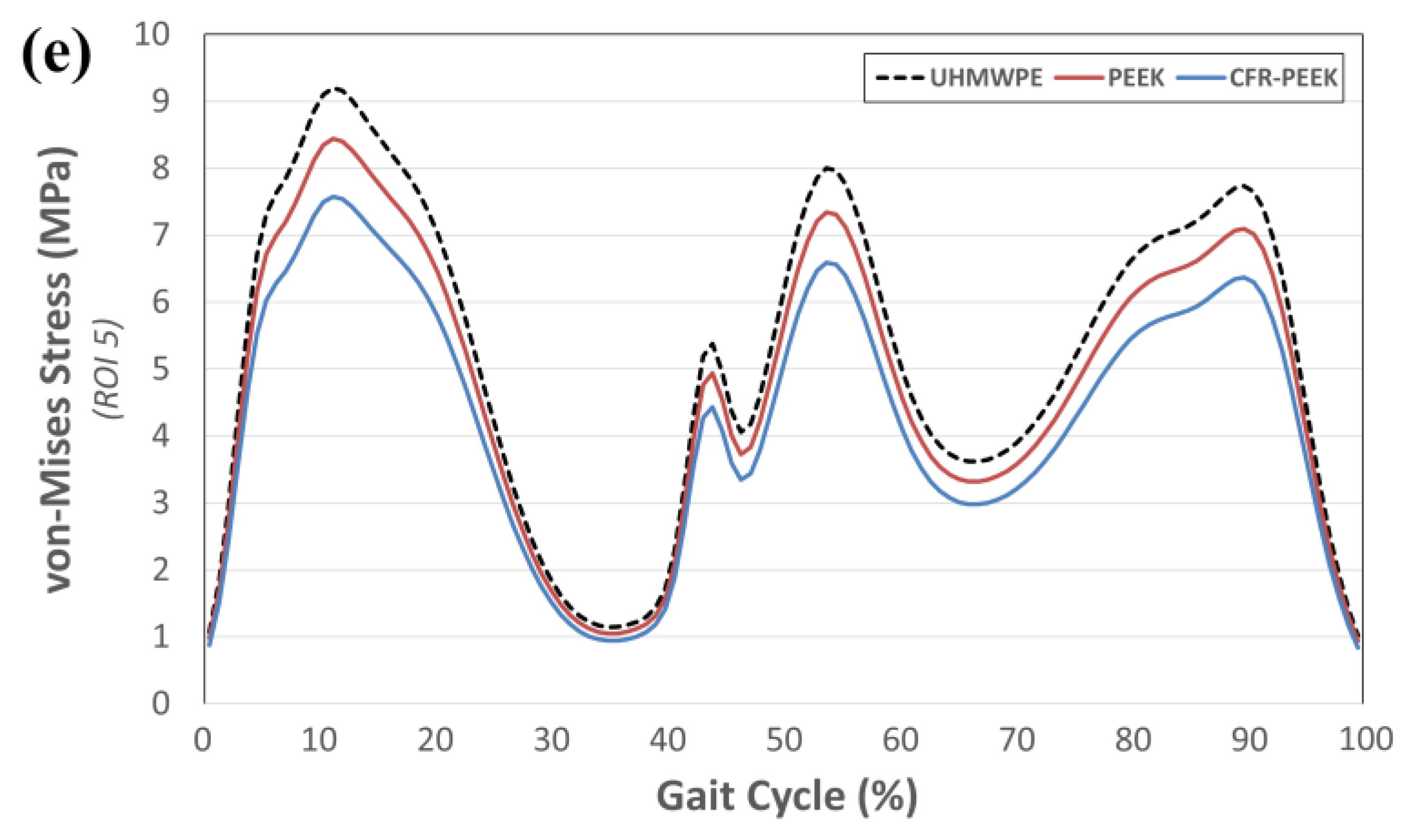
| Material | Modulus of Elasticity | Poisson’s Ratio | |
|---|---|---|---|
| Femoral part | Cobalt chromium alloy (CoCr) | 195 GPa | 0.3 |
| Tibia part | Titanium alloy (Ti6Al4V) | 110 GPa | 0.3 |
| Tibia bearing | UHMWPE | 685 MPa | 0.4 |
| PEEK | 3500MPa | 0.3 | |
| CFR-PEEK | 18,000 MPa | 0.4 | |
| Bone cement | PMMA | 1940 MPa | 0.4 |
© 2020 by the authors. Licensee MDPI, Basel, Switzerland. This article is an open access article distributed under the terms and conditions of the Creative Commons Attribution (CC BY) license (http://creativecommons.org/licenses/by/4.0/).
Share and Cite
Kwak, Y.H.; Hong, H.-T.; Koh, Y.-G.; Kang, K.-T. Biomechanical Effect of Various Tibial Bearing Materials in Uni-Compartmental Knee Arthroplasty Using Finite Element Analysis. Appl. Sci. 2020, 10, 6487. https://doi.org/10.3390/app10186487
Kwak YH, Hong H-T, Koh Y-G, Kang K-T. Biomechanical Effect of Various Tibial Bearing Materials in Uni-Compartmental Knee Arthroplasty Using Finite Element Analysis. Applied Sciences. 2020; 10(18):6487. https://doi.org/10.3390/app10186487
Chicago/Turabian StyleKwak, Yoon Hae, Hyoung-Taek Hong, Yong-Gon Koh, and Kyoung-Tak Kang. 2020. "Biomechanical Effect of Various Tibial Bearing Materials in Uni-Compartmental Knee Arthroplasty Using Finite Element Analysis" Applied Sciences 10, no. 18: 6487. https://doi.org/10.3390/app10186487
APA StyleKwak, Y. H., Hong, H. -T., Koh, Y. -G., & Kang, K. -T. (2020). Biomechanical Effect of Various Tibial Bearing Materials in Uni-Compartmental Knee Arthroplasty Using Finite Element Analysis. Applied Sciences, 10(18), 6487. https://doi.org/10.3390/app10186487





